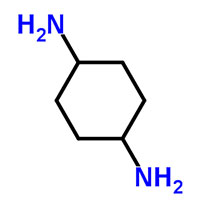Synonyms
Trans-1,4-cyclohexane dicarboxalic acid MonoMethyl ester
1,4-diamino-cyclohexane
EINECS 221-483-6
1,4-Diaminocyclohexane
TRANS-1,4-CYCLOHEXANEDICARBOXYLIC ACID MONOMETHYL
cyclohexane-1,4-diamine
trans-cyclohexane-1,4-dicarboxylic acid monomethyl ester
TRANS-4-CARBOMETHOXYCYCLOHEXANE-1-CARBOXYLIC ACID
Cis or trans or mixture-1,4-diaminecyclohexane
MFCD00035862
trans-1,4-Cyclohexandicarbonsaeure-monomethylester
Methyl trans-4-carboxycyclohexane-1-carboxylate
trans-Cyclohexan-1,4-dicarbonsaeure-monomethylester
Product Description
Introduction:
1,4-Diaminocyclohexane, also known as 1,4-DACH, is a significant chemical compound with diverse
applications in the chemical industry. This product introduction aims to provide an overview of
1,4-Diaminocyclohexane, covering its raw materials, production process, market trends, and the current
status of amino acids in the industry.
Raw Materials:
1,4-Diaminocyclohexane is synthesized from cyclohexane through a series of chemical reactions.
Cyclohexane serves as the primary raw material for the production of 1,4-Diaminocyclohexane.
Production Process:
The production process of 1,4-Diaminocyclohexane involves the following steps:
Step 1: Hydrogenation of cyclohexane - Cyclohexane undergoes hydrogenation in the presence of suitable
catalysts and reaction conditions to convert it into 1,4-diaminocyclohexane.
Step 2: Purification and refinement - The resulting 1,4-diaminocyclohexane is purified and refined using
techniques such as distillation, crystallization, and filtration to achieve the desired level of
purity.
Market Trends:
The market demand for 1,4-Diaminocyclohexane has been steadily increasing due to its diverse
applications across various industries. Here are some key market trends:
Polymer Industry: 1,4-Diaminocyclohexane is widely used in the production of polyamides, such as nylon.
It serves as a key building block in the synthesis of various nylon resins, including nylon 6, nylon 66,
and nylon 610. These polyamides find applications in automotive parts, electrical and electronic
components, fibers, films, and other industrial applications.
Pharmaceuticals: 1,4-Diaminocyclohexane is utilized in the pharmaceutical industry. It is used as an
intermediate in the synthesis of pharmaceutical compounds, including drugs targeting cardiovascular
diseases, anti-cancer drugs, and medications for neurological disorders.
Current Status of Amino Acids:
While 1,4-Diaminocyclohexane is not an amino acid, it is an important chemical compound used in various
applications. Amino acids, on the other hand, play a crucial role in various sectors, including
pharmaceuticals, food additives, animal nutrition, and agriculture. They are essential building blocks
for proteins and have diverse functions in the human body.
Conclusion:
1,4-Diaminocyclohexane, derived from cyclohexane, holds significant value in the chemical industry. Its
production involves the hydrogenation of cyclohexane, followed by purification and refinement. The
market demand for 1,4-Diaminocyclohexane is driven by its applications in the polymer industry,
particularly in the production of polyamides, as well as its usage as an intermediate in the
pharmaceutical industry. Amino acids, although not directly related to 1,4-Diaminocyclohexane, continue
to play a vital role in various industries and contribute to the advancement of chemical
applications.





